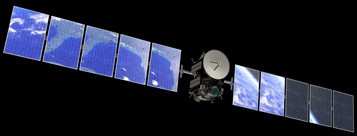Just A Little After Dawn, In Fact
 NASA tells ANN the Dawn spacecraft arrived at Astrotech Space
Operations in Titusville, FL at 0900 EDT Tuesday morning. Dawn,
NASA's mission into the heart of the asteroid belt, is at the
facility for final processing and launch operations. Dawn's launch
period opens June 30.
NASA tells ANN the Dawn spacecraft arrived at Astrotech Space
Operations in Titusville, FL at 0900 EDT Tuesday morning. Dawn,
NASA's mission into the heart of the asteroid belt, is at the
facility for final processing and launch operations. Dawn's launch
period opens June 30.
"Dawn only has two more trips to make," said Dawn project
manager Keyur Patel of NASA's Jet Propulsion Laboratory in
Pasadena, CA. "One will be in mid-June when it makes the 15-mile
journey from the processing facility to the launch pad. The second
will be when Dawn rises to begin its eight-year, 3.2-billion-mile
odyssey into the heart of the asteroid belt."
The Dawn spacecraft will employ ion propulsion to explore two of
the asteroid belt's most intriguing and dissimilar occupants:
asteroid Vesta and the dwarf planet Ceres.
As Aero-News has reported,
NASA scrapped the Dawn program in March 2006, citing cost overruns
and technical glitches. The program was given new life weeks later,
due in large part to protests from scientists and engineers at
JPL.
Now that Dawn has arrived at Astrotech near NASA's Kennedy Space
Center, final prelaunch processing will begin. Technicians will
install the spacecraft's batteries, check out the control thrusters
and test the spacecraft's instruments. In late April, Dawn's large
solar arrays will be attached and then deployed for testing. In
early May, a compatibility test will be performed with the Deep
Space Network used for tracking and communications.
Dawn will then be loaded with fuel to be used for spacecraft
control during the mission. Finally, in mid-May, the spacecraft
will undergo spin-balance testing. Dawn will then be mated to the
upper stage booster and installed into a spacecraft transportation
canister for the trip to Cape Canaveral Air Force Station. This is
currently scheduled for June 19, when it will be mated to the Delta
II rocket at Pad 17-B.
The rocket that will launch Dawn is a Delta II 7925-H
manufactured by the United Launch Alliance; it is a heavier-lift
model of the standard Delta II that uses larger solid rocket
boosters. The first stage is scheduled to be erected on Pad 17-B in
late May. Then the nine strap-on solid rocket boosters will be
raised and attached. The second stage, which burns hypergolic
propellants, will be hoisted atop the first stage in the first week
of June. The fairing which surrounds the spacecraft will then be
hoisted into the clean room of the mobile service tower.
Next, engineers will perform several tests of the Delta II. In
mid-June, as a leak check, the first stage will be loaded with
liquid oxygen during a simulated countdown. The next day, a
simulated flight test will be performed, simulating the vehicle's
post-liftoff flight events without fuel aboard. The electrical and
mechanical systems of the entire Delta II will be exercised during
this test.

Once the Dawn payload is atop the launch vehicle, a final major
test will be conducted: an integrated test of the Delta II and Dawn
working together. This will be a combined minus and plus count,
simulating all events as they will occur on launch day, but without
propellants aboard the vehicle.
 ANN's Daily Aero-Term (04.28.24): Airport Marking Aids
ANN's Daily Aero-Term (04.28.24): Airport Marking Aids Aero-News: Quote of the Day (04.28.24)
Aero-News: Quote of the Day (04.28.24) ANN's Daily Aero-Linx (04.28.24)
ANN's Daily Aero-Linx (04.28.24) Aero-News: Quote of the Day (04.29.24)
Aero-News: Quote of the Day (04.29.24) ANN's Daily Aero-Linx (04.29.24)
ANN's Daily Aero-Linx (04.29.24)




